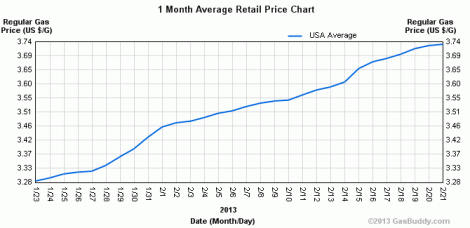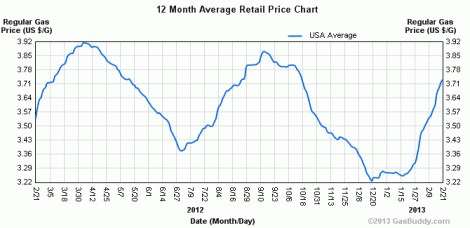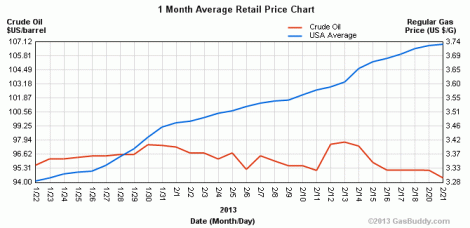
Here’s what gas prices have done over the last month:
This isn’t an unprecedented rise; prices went up last February, too.
What’s odd, though, is that the recent rise isn’t tied to rising crude oil prices, the traditional reason prices fluctuate.
So what’s happening? The Washington Post dug into it, noting concerns over Middle East stability, lower production by OPEC, and the continuing high price of oil — though crude prices dropped significantly yesterday.
One key factor is limited refinery capacity.
[S]ome analysts … pointed to refinery issues. Several refineries have been shut down for routine maintenance, and in the eastern United States, several refineries simply went out of business in the past year.
“Atlantic Basin capacity closures have improved refining fundamentals,” the nation’s biggest refiner, Valero, said in a slide presentation at a Credit Suisse conference this month. It estimated that refineries have closed nearly 1 million barrels a day of capacity on the East Coast or in the U.S. Virgin Islands in the past two years, which Valero said allowed it to increase profit margins.
Refinery constraints were a key factor in California’s huge gas price spike last summer. Let’s go back to the law of supply and demand. Less supply means increased demand, which means more profits. Valero’s suggestion that reducing refinery capacity increased profit margins falls squarely in line with that: Less crude oil refined into gasoline means less gasoline, which means a higher price per gallon. Granted, these refineries didn’t all close this month, but combined with other factors, the closures appear to be playing a role — and may help explain why the price of gas is going up independent of the price of crude oil.
Let that be consolation to you next time you go to fill up. It’s just basic supply and demand, manipulated by oil companies. As it always has and always will, the system works.







